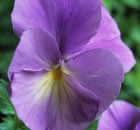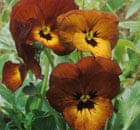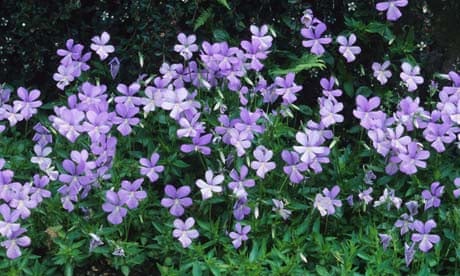Garden centres are filling up with bedding pansies, often in packs of mixed colours. All great fun, but a nuisance if you want simpler colour schemes. This is a group of flowers under constant development, so seed merchants are selling some splendid single-colour strains in blues, ambers, wonderful Morocco leather reds, and even pitch black.
If, though, you want serious control over your colour schemes, then why not explore some of the named varieties of pansies' posh relatives?
The pansy developed in the early 19th century as a complex hybrid of several species of viola growing in Virginia, but simpler crosses, often with a lot of Viola cornuta in them, became the violas and violettas. Lacking the black central blotch, or 'face', that caused such a stir in sentimental Victorian hearts, the colours are clear, often subtle, and many of the varieties are deliciously perfumed.

Violas have the largest flowers. Try some of the 'show' violas like the thrilling 'Pickering Blue' or the misty mauve of 'Maggie Mott'. For more riches, try gorgeous velvety purple of 'Lord Plunkett', or the equally luscious, if less floppy, 'Martin'. 'Mosely Perfection', getting rare now, is a rich yellow. Subtler, and smaller, are the soft greyish pinks of 'Hazlemere' and 'Sissinghurst Pink'.
Violas grade into the violettas, plants even closer to V. cornuta, itself a lovely thing even in its basic blue or white flowered form. Violettas retained a good bit of the delicacy of shape of the V. cornuta flower, as well as that species' matted habit of growth, but combined these with an ability to flower more freely and for longer periods. The first violettas were white or light-coloured, but the range soon expanded. There are now some marvellous colours, from the faded mauve-pink of 'Lady Saville', to the dusky lilac of 'Lorna', the delectable pale yellow 'Moonlight' and the milky 'Moonraker'. Especially good, both in baskets, and underplanting shrub roses are positively electric blues like 'Julian' or 'Boughton Blue' (also known as 'Belmont Blue').
Violas and violettas are rewarding garden plants, though need rather more care than pansies if you are to keep them from season to season. Greenfly are the worst pest, hiding deep inside the growth points, and eventually killing the plant. Spray regularly with systemic insecticide. Most violas and almost all the violettas are easily divided by pulling the plants apart once there are several stems to do this with. A few months growth and you have can easily have enough for a whopping container, or a bit of really elegant bedding. They're worth pulling apart once a year anyway, best in early spring, as congested plants tend to die off. With posh sorts, dead-heading is often recommended, fine if you have time. It does extend the flowering season, but deadheaders miss self-sown hybrid seedlings, some of which can be magnificent in their own right.

But if seed appeals generally, there are good seed strains of V. cornuta hybrids. 'Arkwright's Ruby' amply lives up to its description.
'Bleu de Paris' does the same with its. 'Chantreyland' is a deliciously scented apricot. Those, and the many others, do easily from a packet.
However, if pansies really have to do, then some of the new single colour strains are excellent. Particularly new are forms with bronze centres that look as if they have a good dose of genes from the old yellow, bronze and grey viola 'Irish Molly' (also now found, micropropagated, at garden centres). 'Karma Blue Butterfly' is a very nice example. If no markings are a necessity, 'Padparadja' is a splendid bronzy orange, and if Gothic appeals, there are some good blacks. Try 'Black Moon'.
Suppliers
For named varieties, try nurseries like Elizabeth & Alasdair MacGregor or Ballyrobert Cottage Garden and Nursery. For seed, try Chiltern Seeds.
David Stuart is a garden writer who divides his time between four gardens - one in London, another in Lincolnshire, yet another in the Scottish Borders, and one in the eastern outskirts of Edinburgh

Comments (…)
Sign in or create your Guardian account to join the discussion